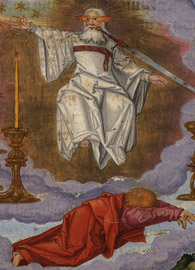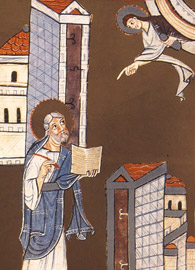Revelation Week 2
Prophet John to the Sevenfold Church: Greetings! (Revelation 1:9–3:22)
By Rob Wall
Seattle Pacific University Paul T. Walls Professor of Scripture and Wesleyan Studies
Read this week’s Scripture: Revelation 1:9–3:22
22:04
Podcast read by Carla M. Wall

 Enlarge
Enlarge
When I was a young child my parents sent my two sisters and me every summer to Camp Wooten in the Blue Mountains of eastern Washington, no doubt to give themselves the vacation they so richly deserved! There for a week my comrades-in-arms and I would play competitive games (including Bible Quiz), clean our cabin better than any other cabin, eat and snack, and meet every morning with counselors to learn more about the Bible. During our afternoon siestas, we would write postcards to our parents assuring them their decision to send us to Camp Wooten was justified by the fun we were having, new friends we were meeting, and the things about God we were learning. We were instructed by our cabin counselor to follow a strict form: “Dear Mom and Dad,” I would begin, “How are you? I am fine. Yesterday we…” And so on. Always the same. I think Mom still has some of those cards tucked away with her other important documents.
John, Revelation’s Divinely Appointed Author
Similarly, in the ancient world personal connections were maintained at a distance by exchanging letters. The particular form in which these letters were written indicated a great deal about the nature of the relationship between writer and recipient, and even the circumstances that occasioned the letter’s writing. Revelation is a letter from a prophet whose authority to write into the life of his audience is not based upon his apostolic office [Author’s Note 1], since nowhere does he mention it, but upon his faithfulness to God’s word that has resulted in his persecution and exile on the remote island of Patmos (Revelation 1:9). [Author’s Note 2] Already, then, the conflict between God’s kingdom and the reign of the evil one (cf. 1 John 5:19), plotted by this book’s narrative, is personified by the prophet’s costly circumstance. Moreover, the key phrase “in the Spirit” (1:10; see 4:2; 17:3; 21:10) [Author’s Note 3] marks him out as God’s prophet whose heightened consciousness of God’s heavenly reign enables him to understand the revelatory visions he is about to receive from Jesus, write down, and then send to the sevenfold church of Asia. [Author’s Note 4]
It is “in the Spirit” that John meets with God’s exalted Son whom he first hears and then envisions as “one who looked like the Human One.” Even though John writes down a detailed description of the man he sees, his purpose is to evoke impressions rather than provide photographic details. One such impression is to hear an echo of the same man we first meet in Daniel 7:13 (see also Daniel 10:4–6) — the one God appoints as the everlasting Lord over all people (Daniel 7:14; cf. Acts 2:36). John does not identify him by name, but rather locates him in the midst of the seven lampstands that represent the whole church (see Revelation 1:20). Nonetheless his majestic and forceful look evokes the impression that he is “ruler of the kings of the earth” (1:5), and the sharp sword that comes from his mouth symbolizes the triumph of God’s word whose promises to Israel have now been realized by the death of the exalted One. [Author’s Note 5]
John’s terror at such an awesome sight is the typical response whenever God makes a house call to commission a prophet to a special task (cf. Exodus 3:2–6; Isaiah 6:5; Ezekiel 1:28; Daniel 10:8–9; Acts 9:4–5). The prophet’s fearful recognition of the living God’s power and holiness is the proper posture to receive God’s instruction. But God’s astonishing response to John’s terror is also crucial to their working relationship: God first relieves John’s fear and then confirms that the one who stands before him is the first who is also the last (cf. Revelation 1:8), the dead one who is now forever alive, and the one and only Lord who now holds the keys that lock up that evil pair, “Death and Hades,” for their eventual destruction (cf. 20:14). This is a can-do Lord!
The Lord, who has singular authority over time and destiny, now commissions John to write about it in the visions he is soon to see and hear (1:19). The most crucial element of John’s self-introduction concerns his authority to write Revelation, in response to which his audience is compelled to hear what is written. While his apostolic witness of the historical Jesus (1:2) and evident knowledge of Israel’s biblical story enable John to interpret and write knowingly about “the mystery” revealed to him in the visions he is about to receive (1:20), his prophetic authority is not self-appointed or church-appointed but divinely appointed of “the one who looked like the Human One” (1:13). A “mystery” is not a problem that seeks a solution, but an answer unveiled by a revelation.
John’s Diagnosis of the Church, Then and Now

 Enlarge
Enlarge
The author’s personal greeting of an audience in antiquity is typically shaped by his perspective of them: who and where they are, and what he thinks are their key identifying markers. This frames whatever else he writes to them in the rest of the letter. John’s perspective is shaped by the vision he receives of them, which he draws in Revelation 2–3. Some interpreters have even suggested that the whole of Revelation is contained in these two chapters. We may suspect this is so because the prophet addresses his audience by using roughly the same “thus says” formula used by Old Testament prophets when speaking God’s word to Israel: “these are the words” of the exalted Lord to seven local congregations that define what will attract or discourage his presence and participation with his people. [Author’s Note 6] Like those of Old Testament prophets, John’s addresses are the oracles of a prophet who both diagnoses the community’s current spiritual health and then prescribes what it must do to “overcome” evil to live with God forever. These are therefore crucial chapters for finding our theological legs and tracking down God’s word for today’s congregations.
The word used for “church” (ekklēsia) is repeated fifteen times in these two chapters, and then only once more in the rest of the book. What it means to be the “church” from the Lord’s angle of vision is clearly the focus of the prophet’s address. The primary meaning of “church” targets a particular group of believers gathered together in real places for worship and witness. Revelation’s initial mailing address is seven local congregations in Roman Asia, but the number seven symbolizes the “permanent address” of the church universal. In this sense, the messy mixture of local culture and Christian faith that the living Jesus found in the local congregations over which the apostle John had oversight is the same he might find in the whole church at any given time. [Author’s Note 7]
John writes down what he sees and hears in carefully crafted literary patterns so that those hearing Revelation read aloud will not miss the Lord’s message for them. First, his messages for each congregation follow the same outline for effective communication. Each opens with a description of the community’s experience of its exalted and living Lord (2:1, 8, 12, 18; 3:1a, 7, 14) who is present in their midst and closely observant of how they conduct their spiritual and moral lives (see 1:13, 20; 2:1).
For this reason, the second part of each oracle begins with an ominous “I know your works” (2:2, 9, 13, 19; 3:1b, 8, 15), which introduces a catalog of accusations and/or commendations that evaluate the congregation’s readiness to receive the Lord upon his any-moment return (2:5, 16, 25; 3:3, 11, 19) and so to participate in his final conquest over death (2:7, 10, 26–28; 3:5, 12, 21). The steady mention of a congregation’s “works” (2:2, 5, 6, 19, 22, 23, 26; 3:1, 2, 8, 15) makes it clear that Christ measures discipleship by orthopraxy (works in keeping with Christ’s example) — by a congregation’s practices in loving response to God and by rejecting the various evils (religious and cultural) that surround and threaten its life with Christ.
A final part of each oracle regards the congregation’s responsiveness to the Lord’s exhortation, “If you can hear, listen to the Spirit” (2:7, 11, 17, 29; 3:6, 13, 22). Whether or not to repent and restore a right relationship with the Lord mostly depends on the congregation’s spiritual need and capacity to do so. Those who need to “repent” (i.e., to reorient themselves to a life like Christ’s) and who do so will “emerge victorious” at day’s end and participate in God’s new creation — the markers of which are everywhere mentioned in concluding each oracle (e.g., “the tree of life that is in the paradise of God,” 2:7, cf. 22:2; “the hidden manna” and “the white stone,” 2:17 cf. 21:5; “a place with me on my throne,” 3:21 cf. 22:3).
What We Can Learn from the Seven Churches
How one listens to Revelation, whether in terror at the warnings to repent from present sin or in shalom at the exhortations to hope for the Lord’s coming victory, depends in which congregation’s pew you sit! John’s seven oracles are precisely arranged so that the two congregations in gravest danger are those first and last mentioned (Ephesus and Laodicea), while the congregations in best shape (Smyrna and Philadelphia) are placed after and before these two in stark contrast. The other three congregations, noteworthy because of the description of their middling spiritual life, are appropriately found smack in the middle (Pergamum, Thyatira, Sardis).
The contrasting pairs that begin and conclude the prophet’s address have gained the most attention during the history of Revelation’s interpretation. And for good reason! The haunting images of the abandoned first love of the Ephesian believers (2:4) or of the Lord spitting out the lukewarm works of the Laodiceans (3:16) remind us that giving up a demanding discipleship by giving in to a feel-good or secular religion undermines our life with Christ. Indeed, the threats come from all directions, both within the churches, especially from teachers who have departed from the apostolic witness (e.g., 2:13–15, 20–23), and from the pressures of cultural expectation. The pressure of being a patriotic citizen in Caesar’s empire is not so different from the threat many Christians experience today, when being a “loyal American” invites compromise of our allegiance to God’s reign (cf. 2:9–10) or when routine business practices emphasize financial profit at the expense of Christian virtue (cf. 3:17–18). God’s people are responsible for God’s reputation in the world and therefore must resist any practice that subverts our “love, faith, service, and patient endurance” (2:19).
Nonetheless, the centerpiece of John’s address to the sevenfold church is what the Lord has to say for the congregation at Thyatira (2:18–29), and we should read Revelation accordingly. There are three literary clues we should pick up in recognizing the importance of this often neglected oracle. First, it stands at the center of an inverted parallelism (ABCDC’B’A’) that pairs its first and seventh, second and sixth, and third and fifth members by their common form and linking words. That is, what we find read aloud at the place where two parallel lines intersect — where “X marks the spot” — intends to attract the hearer’s attention. Second, this oracle to Thyatiran believers is the longest and most complex of the seven congregations. The sheer length of a biblical passage is often a cue to heighten our interest in studying it more closely. Finally, the use of Psalm 2:9 in Revelation 2:26–27 introduces one of Revelation’s essential co-texts (cf. 11:15, 18; 12:5; 14:1; 19:15): the entire book envisions the victory of the triune God over the rebellious nations currently under the control of an unholy trinity (= the evil one and two beasts; cf. Revelation 12–13).
But the real importance of Thyatira is that its congregational profile is so familiar to us! This is a membership of rank-and-file believers like us, whose everyday struggles and practical concerns are those of most Christians in every age. These believers make up the spiritual majority to whom Revelation is addressed. Thyatira was a city known for its trade guilds (think labor unions), membership in which would have involved idolatry. There was precious little idol-free space for urban Christians of antiquity. Their activities of daily life required decisions in business and social life that implicated one deeply in local traditions of idol worship (not unlike our own world of social media and personal technologies that preoccupy us and integrate us into a culture of self-absorption).
The Old Testament prophets speak of idolatry as a failure of attentiveness — the inability or unwillingness to focus our attention and desire upon God in the face of myriad distractions. John draws upon this prophetic criticism to frame the congregation’s divided attention (2:20), as well as their acceptance of a false prophet (Jezebel; cf. 2 Kings 9) who apparently tolerated the routines of this idolatry with impunity as a way of getting ahead in business and social standing (2:20). [Author’s Note 8]
The Lord’s concluding note promises himself to those who overcome (i.e., repent; 2:22) and continue to do “my works” (2:26a). Jesus is “the morning star” (2:28), which is yet another striking metaphor of his messianic reign (cf. Numbers 24:17; Isaiah 60:3), specifically of the light that dawns at the daybreak of the new creation to illumine the nations of God’s victory. The remnant of those believers in Thyatira and Seattle who repent and do the Lord’s works — by rejecting the false prophet and avoiding idols — bears witness to this bright future.
Questions for Further Reflection
- How do we know the letters to the seven churches also apply to us today?
- What evidence is there that a Christian’s orthopraxy is a concern of Jesus?
- Give three reasons to pay special attention to the letter to Thyatira.
- According to this writer, modernity seems particularly idolatrous. How can a modern Christian avoid this pitfall of modern life?
<<Previous Lectio Back to Revelation Next Lectio>>

This work is licensed under a Creative Commons License.





appreciate this series. thank you.